English 




Views: 222 Author: Astin Publish Time: 2025-02-20 Origin: Site



Content Menu
● Strength and Resistance to High Winds
● Design Freedom and Aesthetic Flexibility
● Energy Efficiency and Thermal Performance
● Environmental Impact and Sustainability
● Potential Disadvantages of uPVC Windows
● Aluminum Windows: Pros and Cons
>> Pros:
>> Cons:
>> Pros:
>> Cons:
● FAQ About Aluminum and uPVC Windows
>> 1. What is the lifespan of aluminum windows?
>> 2. Are aluminum windows energy efficient?
>> 3. Do uPVC windows require a lot of maintenance?
>> 4. Are aluminum windows suitable for coastal areas?
>> 5. Which type of window offers better sound insulation?
Selecting the right type of windows is a critical decision for any homeowner or builder. Windows not only contribute to the aesthetic appeal of a building but also play a significant role in energy efficiency, security, and overall comfort. Among the various options available, aluminum and unplasticized polyvinyl chloride (uPVC) windows are two of the most popular choices. Each material offers unique benefits and drawbacks, making the decision-making process complex. This article aims to provide a comprehensive comparison of aluminum and uPVC windows to help you determine which is the better option for your specific needs.

Aluminum windows currently hold a substantial share of the Indian market, estimated to be over 50%, while uPVC windows account for approximately 15-18%[1]. Aluminum is often perceived as a more premium material due to its metallic nature, whereas uPVC is a type of plastic[1]. The vibrant color options available for aluminum windows make them a popular choice for upscale construction projects, while uPVC windows are typically available in white, making them easily distinguishable[1].
When it comes to structural strength, especially in regions prone to high winds, the choice between uPVC and aluminum windows becomes crucial. uPVC windows gain their strength from steel reinforcements within the window profile[1]. The larger the steel section, the stronger the window, but this also results in a bulkier design that reduces the amount of light entering the room[1]. Additionally, the welded corners of uPVC windows can be a weak point, making them less suitable for high-rise buildings or larger windows[1].
Aluminum windows, on the other hand, can be designed to withstand varying wind pressures depending on the building's location, such as coastal areas. Thicker sections of aluminum offer greater resistance, and the mechanically joined corners provide enhanced stability[1]. This construction also simplifies transportation, as aluminum windows can be easily disassembled and moved, unlike uPVC windows that are welded and more difficult to maneuver in tight spaces[1].
Durability is a key factor to consider when selecting windows, as it directly impacts their lifespan and maintenance requirements. uPVC windows are susceptible to damage from ultraviolet (UV) rays, which can cause them to become brittle and yellow over time[1]. This issue is exacerbated if the manufacturer reduces the titanium dioxide (TiO2) content in the material, a factor that is difficult to detect in new windows[1].
Aluminum windows are significantly more durable, with anodized and weather-resistant coatings that prevent corrosion, particularly in coastal environments[1]. Aluminum windows also have a longer lifespan in tropical climates like India, as they are largely unaffected by UV rays[1]. The hardware used in aluminum windows is generally more corrosion-resistant, and the metal-to-metal lock fixing enhances their security[1]. Furthermore, aluminum windows are easier to operate due to larger rollers, and features like door closures and child safety catches can be easily integrated[1].
Aluminum windows offer greater design freedom compared to uPVC, making them a preferred choice for architects. Their slim profiles and versatile design options cater to a wide range of architectural styles, from budget-friendly to high-end designs, while also accommodating different weather conditions[1]. The product range of uPVC windows is more limited due to the difficulty in fixing hardware and size restrictions[1]. uPVC windows are better suited for small windows in regions like Europe, where they are primarily used for light and ventilation[1]. However, as architectural trends in India shift towards larger windows with higher ceiling heights and better integration with outdoor spaces, aluminum windows are becoming increasingly popular[1]. Aluminum windows are available in a wide range of styles, colors, and finishes, increasing the odds of finding one that suits your design needs[2]. However, they do tend to be thinner than traditional wood windows, which some people dislike[2]. Others appreciate this sleeker, more modern look[2].
Aluminum windows are incredibly low-maintenance[2]. While you may repaint it if you choose, there's rarely a need[2]. Investing in a quality product means that you rarely need to do more than wipe it down occasionally to keep it looking fantastic for the length of its lengthy lifespan[2].
Energy efficiency is an important consideration, especially with rising energy costs and increasing environmental awareness. Aluminum, being a metal, is a good conductor of heat. This means that aluminum windows can transfer heat more readily than uPVC windows, potentially leading to higher energy bills[6]. However, modern aluminum windows often incorporate thermal breaks, which are insulating materials placed between the interior and exterior aluminum frames to minimize heat transfer[6][9]. These thermal breaks significantly improve the energy efficiency of aluminum windows, making them comparable to uPVC windows in terms of thermal performance[6]. uPVC windows, by nature, offer better insulation against noise compared to aluminum ones[5].
The initial cost is often a significant factor in the decision-making process. Aluminum windows tend to be more expensive than uPVC windows[6][9]. The higher cost of aluminum windows can be attributed to the material's inherent properties, manufacturing processes, and the availability of various design options. However, it is essential to consider the long-term benefits and durability that aluminum offers, which can offset the initial investment[6]. uPVC windows might require a higher upfront investment compared to their counterparts[7]. However, it's important to consider the long-term benefits, such as energy savings and reduced maintenance costs[7].
With growing concerns about environmental sustainability, the ecological footprint of building materials is becoming increasingly important. Aluminum is a highly recyclable material, and recycled aluminum retains its properties, making it an environmentally friendly choice[9]. uPVC is also recyclable, but the recycling process is more complex and may not be as widely available as aluminum recycling[9].
The difference between indoor and outdoor temperatures will sometimes cause condensation to form on aluminum windows[2]. Aluminum's high thermal conductivity can sometimes lead to condensation on the frames, especially in regions with significant temperature differences[6]. Proper ventilation and insulation techniques can help minimize this issue and prevent potential moisture-related problems, such as mold growth[6].

Aluminum windows that are properly maintained tend to have an average lifespan of 20 to 25 years[2]. That's slightly longer than vinyl windows tend to last[2].
uPVC windows are light in weight, they cannot be installed in prime locations[3].
Here is a summary of the pros and cons of aluminum windows:
- Strength and Durability: Highly resistant to weather elements, ensuring structural integrity over time[6][9].
- Design Flexibility: Slim profiles allow for larger expanses of glass and various customization options[6].
- Low Maintenance: Does not warp, rot, or corrode, eliminating the need for regular painting or staining[6].
- Environmentally Friendly: Aluminum is recyclable[9].
- Conductivity: Without proper insulation, aluminum can facilitate heat transfer, leading to potential energy loss[6].
- Cost: Aluminum doors and windows tend to be relatively more expensive than some other materials, such as vinyl or uPVC[6].
- Condensation: Aluminum's high thermal conductivity can sometimes lead to condensation on the frames, especially in regions with significant temperature differences[6].
Here is a summary of the pros and cons of uPVC windows:
- Cost Effective: UPVC windows tend to be less expensive than aluminum windows[6][9].
- Insulation: UPVC windows offer better insulation against noise compared to aluminum ones[5].
- Low Maintenance: The maintenance cost is very low with UPVC windows[3].
- Limited Color Options: UPVC has a more limited range of color options[7].
- Less Aesthetic Flexibility: UPVC doors and windows are more fixed in their appearance[7].
- Limited Structural Strength: In areas prone to extreme weather conditions like hurricanes or heavy snowfall, you might need additional reinforcement to ensure they can withstand the forces of nature[7].
Choosing between aluminum and uPVC windows depends on various factors, including budget, design preferences, energy efficiency requirements, and environmental considerations. Aluminum windows offer superior strength, durability, and design flexibility, making them suitable for a wide range of architectural styles and weather conditions. While they may have a higher initial cost, their long lifespan and low maintenance requirements can provide long-term value. uPVC windows, on the other hand, are a cost-effective option that offers good insulation and low maintenance. However, they may not be as structurally strong or aesthetically versatile as aluminum windows. Ultimately, the best choice depends on your specific needs and priorities.

Aluminum windows that are properly maintained tend to have an average lifespan of 20 to 25 years[2].
Aluminum windows can be energy efficient, especially when designed with thermal breaks that minimize heat transfer[6][9].
No, uPVC windows have very low maintenance requirements[3].
Yes, aluminum windows are highly durable and corrosion-resistant, making them suitable for coastal environments[1].
uPVC windows generally offer better sound insulation compared to aluminum windows[5].
[1] https://www.tostemindia.com/blog/what-is-the-difference-between-upvc-windows-and-aluminium-windows/
[2] https://www.americanwindowcompany.com/the-pros-and-cons-of-aluminum-windows/
[3] https://architects4design.com/upvc-windows-know-advantages-durability-maintenance-disadvantages-of-upvc/
[4] https://gist.github.com/allenfrostline/c6a18277370311e74899424aabb82297
[5] https://en.lesso.com/blogs/upvc-windows-vs-aluminum-windows/
[6] https://www.winlock.co.uk/blog/pros-and-cons-of-choosing-aluminum-doors-and-windows
[7] https://mccoymart.com/post/upvc-doors-windows-advantages-and-disadvantages/
[8] https://blog.csdn.net/qq_34917728/article/details/125122327
[9] https://www.checkatrade.com/blog/expert-advice/aluminium-vs-upvc-window-decision/
[10] https://www.harringtonwindows.com/post/what-is-the-disadvantage-of-upvc-windows
Top Aluminum Furnitures Manufacturers and Suppliers in Thailand
Top Aluminum Furnitures Manufacturers and Suppliers in Singapore
Top Aluminum Furnitures Manufacturers and Suppliers in India
Top Aluminum Furnitures Manufacturers and Suppliers in South Korea
Top Aluminum Furnitures Manufacturers and Suppliers in Japan
Top Aluminum Furnitures Manufacturers and Suppliers in Europe
Top Aluminum Furnitures Manufacturers and Suppliers in America
Top Aluminum Curtain Wall Profiles Manufacturers and Suppliers in Czech Republic
Top Aluminum Curtain Wall Profiles Manufacturers and Suppliers in Poland
